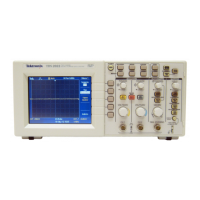Command Descriptions
TDS200/1000/2000 Series Oscilloscope Programmer Manual
2−121
MEASUrement:MEAS3:VALue?
might return 28.75E6 if measurement number three is frequency.
*OPC
The *OPC? query and the *OPC set command provide two different
methods for checking for the completion of the commands listed in
Table 2-21 on page 2-121, such as single sequence acquisitions.
The *OPC? query uses a more simple method than the *OPC set
command. The *OPC? query places the ASCII character “1” into the
output queue when all pending operations listed in Table 2-21 are
complete. If none of the operations are pending, the *OPC? query
immediately places a “1” in the output queue.
NOTE. When using the *OPC? query method, the time-out on your
controller must be set for longer than the operation for which the
controller is waiting, such as a single sequence acquisition.
Unlike the *OPC command, the *OPC? query does not affect the
OPC Event bit in the Standard Event Status Register (ESR).
The *OPC set command uses a more complex method than the
*OPC? query. However, there are advantages to using this method in
some situations. For more information, refer to Using the *OPC Set
Command on page 3-14. Table 2-25 lists commands that generate an
Operation Complete message.
Table 2−25: Commands that generate an Operation Complete message
Command Operation
*CAL?, CALibrate:CONTINUE,
CALIbrate:FACtory, CALIbrate:INTERNAL
Internal self−calibration
ACQuire:STATE ON or
ACQuire:STATE RUN
(when ACQuire:STOPAfter is set to SEQuence)
Busy single sequence
acquisition
HARDCopy STARt Busy hardcopy output
Examples

